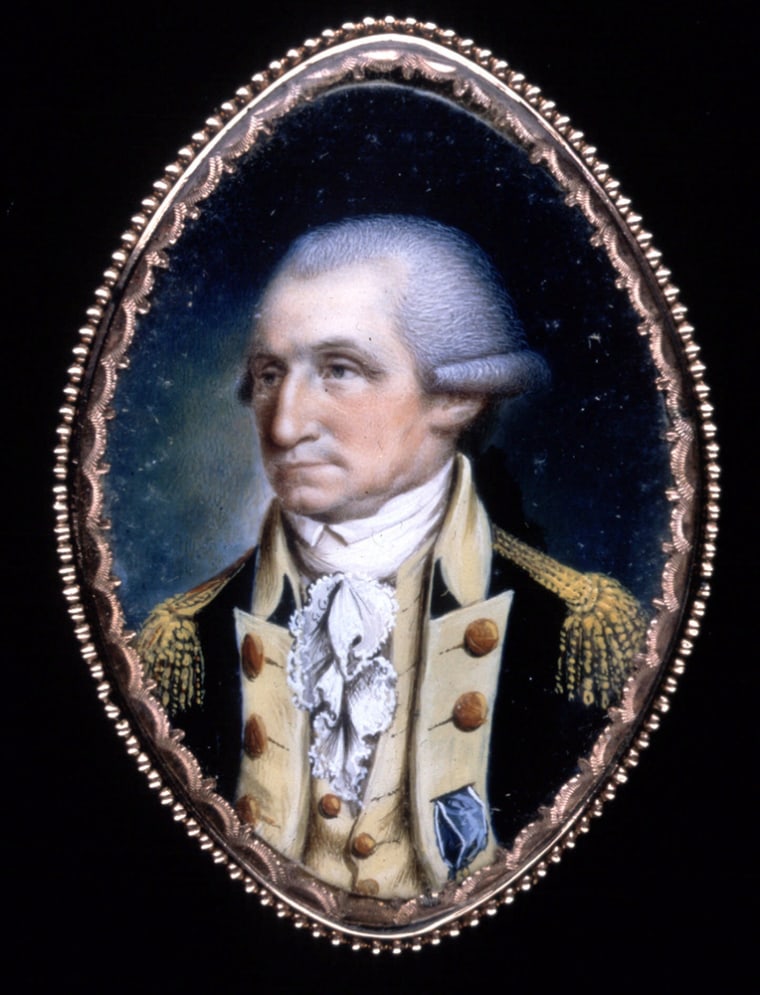Americans know George Washington as the dour founding father with white hair and ponytail depicted on U.S. currency, but most people have little idea what the nation’s first president really looked like beyond this stock image.
Researchers are hoping to change that by embarking on a massive detective hunt to flesh out his appearance in every detail. Specialists at Washington’s home in Mount Vernon, 16 miles (25 kilometers) outside Washington, are gathering dozens of artifacts including snippets of hair and clothing that will be analyzed over the next year.
Based on that information, they will make lifesize models of the former president at three different points in his life, which will go on display in 2006 as part of a new $85 million education center and museum at Mount Vernon.
Sculptures, molds, busts, dentures, imprints and masks of the former president’s face and body will be scanned with lasers. Hair samples, eyeglasses, personal clothes and all available written description of Washington’s physique, including those written by the president himself, will also be scrutinized.
“We want to show visitors the real George Washington, and showing visitors how he looked is critical to that goal,” said James Rees, Mount Vernon’s executive director.
The scans will be merged and used to create detailed computer images that can be fine-tuned, said computer scientist and project participant Anshuman Razdan, director of Partnership for Research in Spatial Modeling, or PRISM, at Arizona State University.
“We will depict Washington at three distinct phases of his life — a surveyor and young frontiersman at 19, commander in chief of the Continental Army during the Revolutionary War at age 45, and first president of the United States at age 57,” Rees said.
Washington's changing visage
Washington, who had red hair as a young man, began losing his teeth in his 20s, said Jeffrey Schwartz, an anthropologist and forensic scientist at the University of Pittsburgh.
He had several pairs of dentures, and historians believe he was portrayed with a closed mouth and tight lips because of the pain and embarrassment he suffered from losing his teeth and wearing dentures. The version that might hint at what Washington would have looked like smiling is the 19-year-old, Schwartz said.
Because of the bone loss that results from losing teeth, the shape of Washington’s face probably changed dramatically over the years, he said, explaining that pinpointing those changes in the different versions of Washington will be hard.
“It’s a challenge, but it’s not unsurmountable, and of course it’s always going to be within the realm of the most reasonable combination of the information that I have at hand,” Schwartz said.
Fine-tuning the face
Schwartz and Razdan will explore various computer-generated images of Washington with and without his dentures, and as a result will able to see how his face might have changed.
Various objects will be studied to make the most accurate depiction of Washington at 53, the age when the two well-known pieces of him were made by French sculptor Jean-Antoine Houdon — a bust from 1785 and a marble statue between 1785 and 1791.
Using the 53-year-old model as a starting point, years will be added and subtracted with Schwartz’s trained eye and the help of Razdan’s PRISM computer program.
Schwartz will use “the consistency of representation of any of his features across an array of portraits and three-dimensional representations” to make his decisions on how to portray Washington.
The most accurate replicas would have been based on studying his bones. Although he is buried at Mount Vernon, museum directors decided against exhuming his body.
Making the models
Museum model designer Ivan Schwartz and his team will then create three 6-foot-plus (1.9-meter) models from foam forms using Razdan’s data.
“It’s like Madame Tussaud’s, but better,” said Schwartz, director of the Brooklyn-based StudioEIS, referring to the wax models made of celebrities. “This is the marriage of the science and the craft.”
“The head is the most labor-intensive part of the process,” he said. The head will first be made of clay from a cast of the foam, and then made into wax. Washington’s body will stay as foam but may have layers of plaster and other material added to it to detail muscles and other contours.
Hair will be implanted into the wax head, and glass eyes inserted. A painter will try to capture Washington’s skin tones in the three models. Finally, period clothing will complete the lifelike replicas.
Washington, born in Virginia in 1732, was a successful surveyor before joining Virginia’s military. He had a major role in the French and Indian War in the 1750s and later as commander of the Continental Army in the Revolutionary War, which ended in victory for Washington in 1781.
In 1789, Washington was inaugurated as the first president of the United States. He served two terms and was the only U.S. president to be elected unanimously by the electoral college. He died in 1799.
